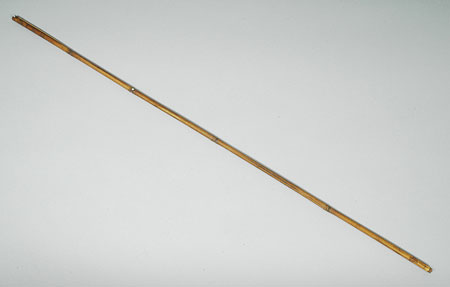Accession Number:
1944.10.74
Country:
Sudan
Region:
Blue Nile ?Darfung
Cultural Group:
?Burun
Date Made:
By 1912
Materials:
Cane Plant
Process:
Carved , Notched , Socketed , Decorated , Incised
Dimensions:
Shaft L = 846, diam = 8.2 x 8, nock L = 10 mm [RTS 27/5/2005].
Weight:
19 g
Other Owners:
L. Gorringe and Mrs L. Gorringe
Field Collector:
L. Gorringe
PRM Source:
Mrs L. Gorringe
Acquired:
Donated October 1944
Collected Date:
1902 - 1912
Description:
Arrow shaft cut from a length of yellowish brown cane (Pantone 729C) with parts of 6 segments preserved along its length.
The top of the shaft corresponds with one of the joints between body segments, and thus has a natural taper.
This has been hollowed out to form a socket, into which the tanged base of the arrowhead would have been originally fitted and then bound round with hide strips, now missing, although there is a reserved band around the shaft showing where this was seated.
The lower part of the shaft has been decorated with what may be an owner's mark, consisting of 3 horizontal bands around most of the circumference, with each band made up of 5 short incised lines.
Below this, the base of the shaft has been nocked, with 2 rectangular notches cut into opposite sides.
There would have originally been a second section of binding just above the nock, to prevent the cane splitting during use, although this is also missing.
The shaft is complete in itself, but has split badly down its upper and lower body.
It has a weight of 19 grams, a body length of 846 mm, nock length of 10 mm and a diameter of 8.2 by 8 mm.
Collected by L. Gorringe at some time between 1902 and 1912, possibly from Darfung, and donated to the Pitt Rivers Museum by his wife, Mrs L. Gorringe.
For a group of bows collected by Gorringe, and possibly from the Burun, see 1944.10.28-34; for additional Burun arrows, see 1944.10.34-71. This arrow is of the same type as 1944.10.37-71, which have narrow ebony points, and hide binding around the junction of arrowhead and shaft, and immediately above the nocked butt.
Rachael Sparks 29/8/2005.
Collected by L. Gorringe at some time between 1902 and 1912, possibly from Darfung, and donated to the Pitt Rivers Museum by his wife, Mrs L. Gorringe.
For a group of bows collected by Gorringe, and possibly from the Burun, see 1944.10.28-34; for additional Burun arrows, see 1944.10.34-71. This arrow is of the same type as 1944.10.37-71, which have narrow ebony points, and hide binding around the junction of arrowhead and shaft, and immediately above the nocked butt.
Rachael Sparks 29/8/2005.
Primary Documentation:
Accession Book Entry
[p.
375] -
Mrs L.
GORRINGE, Rosaries Farm, Ngong, Kenya
.
Specimens collected by her late husband, Captain L.
Gorringe, M.C., in the ANGLO-EGYPTIAN SUDAN between 1902 and 1912.
Undocumented.
[p.
383] 1944.10.72-77 - [1 of] Six arrows of the same type [as 1944.10.37-71, cane shafts deeply notched with ebony spike heads tanged into the shaft], with more or less damaged shafts, one without the ebony head.
Same data [Probably the BURUN of DAR FUNG].
Card Catalogue Entry - There is no further information on the object catalogue cards ['Weapons - offensive - Archery - Arrows' RTS 23/7/2004].
Pitt Rivers Museum label - AFRICA, Sudan. Probably Burun tribe of Darfung. Cane arrow shaft. Don. Mrs L. Gorringe. 1944.10.74 [plastic label, tied to object; RTS 27/5/2005].
Written on object - BURUN, DAR FUNG, A.-E. SUDAN. 1944.10.74 [RTS 24/5/2005].
Card Catalogue Entry - There is no further information on the object catalogue cards ['Weapons - offensive - Archery - Arrows' RTS 23/7/2004].
Pitt Rivers Museum label - AFRICA, Sudan. Probably Burun tribe of Darfung. Cane arrow shaft. Don. Mrs L. Gorringe. 1944.10.74 [plastic label, tied to object; RTS 27/5/2005].
Written on object - BURUN, DAR FUNG, A.-E. SUDAN. 1944.10.74 [RTS 24/5/2005].





